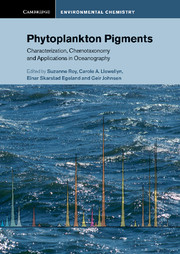Book contents
- Frontmatter
- Contents
- Contributors
- Preface
- Acknowledgements
- Abbreviations and symbols
- Part I Chlorophylls and carotenoids
- Part II Methodology guidance
- Part III Water-soluble ‘pigments’
- 9 Phycobiliproteins
- 10 UV-absorbing ‘pigments’: mycosporine-like amino acids
- Part IV Selected pigment applications in oceanography
- Part V Future perspectives
- Part VI Aids for practical laboratory work
- Part VII Data sheets aiding identification of phytoplankton carotenoids and chlorophylls
- Index
- Plate Section
- References
10 - UV-absorbing ‘pigments’: mycosporine-like amino acids
Published online by Cambridge University Press: 05 March 2012
- Frontmatter
- Contents
- Contributors
- Preface
- Acknowledgements
- Abbreviations and symbols
- Part I Chlorophylls and carotenoids
- Part II Methodology guidance
- Part III Water-soluble ‘pigments’
- 9 Phycobiliproteins
- 10 UV-absorbing ‘pigments’: mycosporine-like amino acids
- Part IV Selected pigment applications in oceanography
- Part V Future perspectives
- Part VI Aids for practical laboratory work
- Part VII Data sheets aiding identification of phytoplankton carotenoids and chlorophylls
- Index
- Plate Section
- References
Summary
Description and role of MAAs
It is now generally believed that natural ultraviolet-A radiation (UV-A, 315–400 nm) and ultraviolet-B radiation (UV-B, 280–315 nm) are strong environmental factors affecting both productivity and community structure in marine and terrestrial ecosystems (de Mora et al., 2000). Reduction of the stratospheric ozone layer, which has caused an increase in the UV-B flux to the Earth's surface in recent years (Farman et al., 1985), could result in increased levels of UV-induced damage for most living organisms (Vincent and Neale, 2000), producing a great impact on the photosynthetic carbon fixation by plants and, consequently, on the global climate change (UNEP, 2006). At the beginning of the evolution of life on Earth, UV-B flux rates clearly exceeded the present values (Cockell and Horneck, 2001) resulting in the evolution of several protection strategies to counteract the negative effects of UV radiation (Roy, 2000). One of the adaptations whereby phytoplankton can reduce UV-induced damage is the synthesis of compounds that can absorb the damaging wavelengths and dissipate the absorbed energy without generating phototoxic reactive intermediates. A variety of such compounds have been found in aquatic and terrestrial plants (Rozema et al., 2002).
As early as 1938 there were observations of UV-absorbing compounds in marine algae (Kalle, 1938; referenced in Sivalingam et al., 1974). This was followed in 1969 by reports of UV-absorbing substances (named S-320) in water extracts from several species of corals and a cyanobacterium (most likely Trichodesmium) from the Great Barrier Reef (Shibata, 1969). Mycosporine-like amino acids (MAAs) from marine organisms were first isolated and characterized by Hirata and co-workers (Hirata et al., 1979). They isolated and characterized mycosporine-glycine from the tropical zoanthid Palythoa tuberculosa (Ito and Hirata, 1977), a compound previously isolated from mycelia of sporulating fungi (Favre-Bonvin et al., 1976), and then described several related imine derivatives of mycosporines (Hirata et al., 1979). Since then, more than 20 closely related MAA compounds have been isolated and characterized from several plants and marine animals (Figure 10.1 and Table 10.1). Wide ranging studies indicate that these compounds occur in virtually all taxa of marine and freshwater cyanobacteria and algae, in invertebrate–microbial symbioses and in metazoans (Karentz et al., 1991; Gröniger et al., 2000; Karentz, 2001).
- Type
- Chapter
- Information
- Phytoplankton PigmentsCharacterization, Chemotaxonomy and Applications in Oceanography, pp. 412 - 442Publisher: Cambridge University PressPrint publication year: 2011
References
- 3
- Cited by



